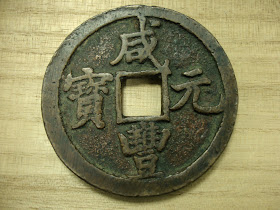In around Year 1928, the China land war period, the Chinese Communist lead workers and peasants adopting the policy to encircle and to seize the cities by means of armed revolutionary rural districts. This policy was implemented along two lines; the development of trained, disciplined Red armies able to withstand the attacks of the KMT troops, and the organization of political power in whatever areas could be brought under Communist control, in the form of soviets, following the model of the Russian Revolution.
As Red army grew in size and took over several areas (we call Soviet Area), finally, on
November 7,
1931, the anniversary of the 1917 Russian
Bolshevik Revolution, with the help of the
Soviet Union, a National Soviet People's Delegates Conference took place in
Ruijin (瑞金), Jiangxi province, which was selected as the national capital. "Chinese Soviet Republic" (CSR; Chinese: "中華蘇維埃共和國") was born, even though the majority of China was still under the control of the nationalist
Government of the Republic of China.
The Soviet Areas were entirely autonomous. The Communists maintained their own police and bureaucracy. In order to strengthen CSR’s political power, development Soviet Areas economic and supporting revolution war, CSR has established and issues its own banknotes, as well as their own coins. The Chinese Soviet Portrait Silver Coins were just issued at this period. Some people used to call it “ Lenin Dollar”.
According “Illustrated Catalogue of Chinese Gold & Silver Coins—Ching and Republican issues” written by Mr. Lin Gwo Ming, there are four kind of Chinese Soviet Portrait Coins have been found:
First one (please see the picture 1), it’s distinguishing feature is bear a bust of Lenin profile portrait within two circles. Above is the inscription, Chung-kuo Su-wei-ai Tsao, literally, “Chinese Soviet Republic Issue”. Below Lenin is suppose printed the date in Chinese, I-chiu-san-i Nien,”1931 year.” due to such coin only be found two pieces and two of them are un-clearly show the date. On the reverse, it is circled by wreath. At the top is a flower and center bears the value, I-yuan (one), within Chinese Communist symbols-sickle & hammer.
Second one, it bears a bust of Lenin facing right without any circle. Above is the inscription, Chung-kuo Su-wei-ai Kon-he-kow Tsao, literally, “Chinese Soviet Republic Issue”. On the reverse, its center bears the value, I-yuan (one), within Chinese Communist symbols-sickle & hammer. Also, its above is the inscription, Chung-kuo Su-wei-ai Tsao, literally, “Chinese Soviet Republic Issue” that is most distinguishing feature from other Chinese Soviet Portrait Coins.
Third one (please see the picture 2), it bears a bust of Lenin facing right without any circle. Above is the inscription, Chung-kuo Su-wei-ai Kon-he-kow Tsao, literally, “Chinese Soviet Republic Issue”. On the reverse, same as first one, it is circled by wreath. At the top is five star and center bears the value, I-yuan (one), within Chinese Communist symbols-sickle & hammer.
Last one (please see the picture 3), it bears a bust of Lenin facing right within a circle. Above is the inscription, Chung-kuo Su-wei-ai Kon-he-kow Kow Be, literally, “Chinese Soviet Republic Coin”. Below Lenin is printed the date in Chinese, I-chiu-san-i Nien,”1931 year”. On the reverse, same as first one and third one, it is circled by wreath. At the top is five star and center bears the value, I-yuan (one), within Chinese Communist symbols-sickle & hammer.
As lack of resource at Soviet Areas, the Chinese Soviet Portrait Silver Coins were made by manual with using old silver extract from silverware and cartridge shell. In addition, it is punished by stone with variance power, the picture of silver face usually un-clearly and has black oxidation material on face of silver coins. The whole Chinese Soviet Portrait Silver Coins were full of punished sign and the coins were heavy and rich of history sad story. Hold it on hand and watch it, there is un-know feeling and exciting arising from my deep heart. Mao and people in Soviet Areas work hard for their dreams are showing in front of my eyes. It really is very special Silver Coins.
Per Beijing ChengXuan Auctions Co., Ltd record, the Chinese Soviet Portrait Silver Coins have been issued in a small amount and major issue for Red Army. As the army has high floating rate and the
First Front Army's Long March began in October 1934, under the hard environment of war period, the remaining of such kind of silver coins are very rare.
Reference: "THE MONEY OF COMMUNIST CHINA (1927 – 1949) PART I" by John E. Sandrock



































